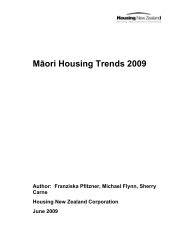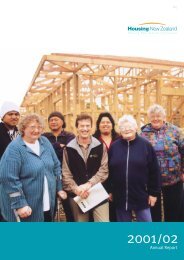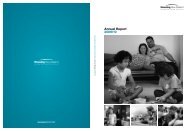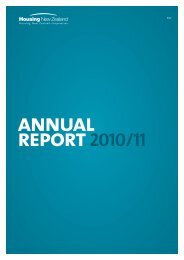MÄori Housing Trends 2010 - Housing New Zealand
MÄori Housing Trends 2010 - Housing New Zealand
MÄori Housing Trends 2010 - Housing New Zealand
You also want an ePaper? Increase the reach of your titles
YUMPU automatically turns print PDFs into web optimized ePapers that Google loves.
Executive summary1 The purpose of this report is to provide an evidence base to inform the developmentof Māori housing policy. This report:• provides an overview of Māori population dynamics• examines current housing trends and outcomes for Māori• discusses the implications of likely population change for future Māori housingneeds• updates the 2009 Māori <strong>Housing</strong> <strong>Trends</strong> report• introduces a new section on selected iwi housing trends.2 Māori continue to be a growing proportion of the <strong>New</strong> <strong>Zealand</strong> population,accounting for 13 percent in 1991 and 14.5 percent of the total population in 2006.The majority of Māori live in urban areas with almost one quarter of Māori living inAuckland.3 In 2009, Māori had a relatively high fertility rate when compared with the totalpopulation. On average, Māori mothers give birth at a younger age than eitherEuropean, or Pacific mothers. The gap in life expectancy between Māori and non-Māori has narrowed since 1997. However, in 2007, life expectancy for Maori is stillapproximately eight to nine years less than non-Māori.4 The Māori population is characterised by a youthful age structure. In 2006, morethan a third (about 34 percent) of the Māori population was under the age of 15years. However, a gradual ageing of the Māori population is occurring. Between2001 and 2006 the median age rose from 22.1 years to 22.9 years. The largestincrease was among the working age population.5 The Māori population is characterised by relatively high rates of mobility. Māori (andPacific peoples) most commonly identify social reasons as the main reason formoving, or not moving. Economic and housing reasons were the next most commonmotivations for Māori (and Pacific peoples) to move. This contrasts with theEuropean experience, where economic reasons tend to be the most importantconsideration, followed by social, and environmental reasons.6 Between 1998 and 2008 Household Labour Force Surveys, there have beendiscernible improvements in the educational status of Māori. The proportion of Māoriwith ‘No qualifications’ fell significantly from 58 to 40 percent, for Europeans thedecrease was 31 to 25 percent, and for Pacific peoples 49 to 44 percent. For Māori,the biggest increases in qualifications were in ‘Other tertiary’ and ‘Bachelors degreeor higher’.7 Gains that Māori have made in training and education should help employmentopportunities. Data from September 2009 shows a 17.2 percent increase in 15 to24 year old Māori engaged in formal study, compared with a year earlier.8 Between the December 2008 quarter to March <strong>2010</strong> quarter, the unemployment ratefor Māori increased from 8.6 percent to 13.6 percent, peaking in December 2009 at14.8 percent. The rise in unemployment for Maori (5 percent) was nearly three timesthe rise for non-Maori (1.8 percent).9 In 2009 the median weekly income for Māori was $480. It had increase 33 percentfrom 2002. However in 2008, the median weekly income for Maori peaked at $499.Māori with a post school qualification (with or without a school qualification) had a1














